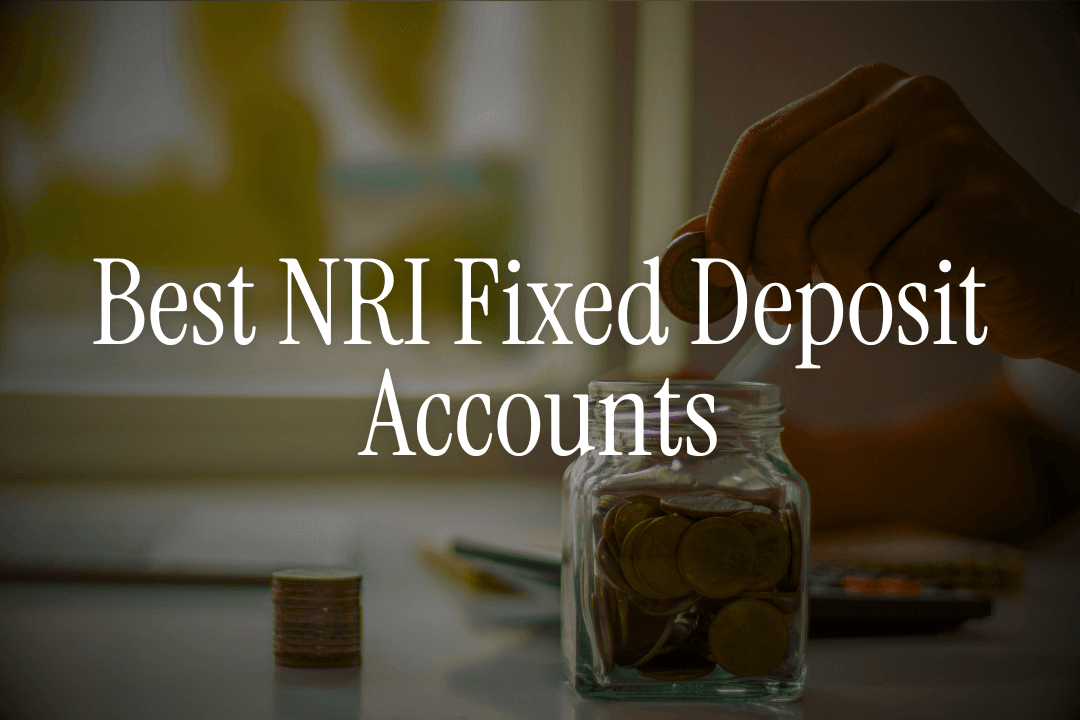
"I have ₹25 lakhs sitting in my UAE savings account earning 1.5%. Should I move it to an NRI FD in India?"
This exact question came up in our UAE NRI WhatsApp group last week. The person asking was a project manager in Dubai, frustrated with low UAE bank rates but worried about Indian banking complexities, tax implications, and whether he'd actually get better returns after all the fees and hassles.
Here's what most articles won't tell you: NRI FDs can give you 6-7% returns, but only if you choose the right type and avoid the common mistakes that cost NRIs thousands of rupees annually.
The "best" FD isn't always the one with the highest advertised rate.
By the end of this guide, you'll know exactly which NRI FD type suits your specific situation, how to minimize tax impact, which banks offer the smoothest digital experience from the UAE, and most importantly - whether FDs are even the right choice for your goals.
Quick Answer: The Summary Verdict
For UAE NRIs in 2025, here's the practical reality:
NRE FDs are best for foreign-earned money you want to grow tax-free (up to 7.50% returns in some banks like SBI).
NRO FDs work for Indian rental income or dividends (but face 30% TDS + 4% cess, effective ~31.2%, potentially reducible to 12.5% under India-UAE DTAA).
FCNR FDs provide currency hedging but lower returns (up to 5.20% for USD in some banks like IDBI).
Top banks for digital experience: ICICI Bank (fastest processing), HDFC Bank (premium service), IDFC FIRST (highest rates with user-friendly app), Axis Bank (good digital opening), SBI (tab-based digital onboarding
The catch: Most UAE NRIs choose based on interest rates alone and ignore tax efficiency, currency risk, and premature withdrawal penalties - leading to lower actual returns than expected.
Our recommendation: Start with NRE FDs for foreign income, use NRO only for Indian income, and consider FCNR for currency hedging on large amounts above $25,000, noting that both principal and interest in NRO can be repatriated up to USD 1 million per financial year after taxes.
What Are NRI Fixed Deposits and Why They Matter
An NRI Fixed Deposit is essentially a time deposit account where you lock your money for a specific period (1-10 years) at a predetermined interest rate. Unlike regular FDs, these come in three types designed for different income sources and tax treatments.
The core appeal: Indian banks offer 6-7% interest rates compared to 1-3% in most international markets. For a UAE resident earning 1.5% on savings, this represents a potential 300-400% increase in returns.
But here's the complexity: The type of NRI FD you choose dramatically impacts your final returns due to tax treatment, repatriation rules, and currency conversion costs.
Real example: Arjun, a Dubai-based consultant, had ₹30 lakhs to invest. He chose a 7% NRO FD without understanding tax implications. After 30% TDS, his effective rate dropped to 4.9%. An NRE FD would have given him the full 7% tax-free.
👉 Tip: The "best" FD rate becomes meaningless if you lose 30% to taxes. Always consider post-tax returns, not advertised rates.

The Complete Breakdown: NRE vs NRO vs FCNR FDs
NRE Fixed Deposits: Tax-Free Growth for Foreign Income
Best for: Foreign-earned money (UAE salary, freelance income, overseas investments)
Key features:
- Tax treatment: Completely tax-free in India (0% TDS)
- Currency: Maintained in Indian Rupees (conversion risk applies)
- Repatriation: 100% of principal and interest
- Minimum tenure: 1 year (no interest if withdrawn before 1 year)
- Joint account: Only with other NRIs, not resident Indians
- Interest rates: 6-7% across major banks
Real scenario: Priya transfers AED 100,000 (₹22.5 lakhs at current rates) from her UAE salary to an NRE FD at 6.5%. After one year, she earns ₹1.46 lakhs interest with zero tax deduction. Total: ₹23.96 lakhs, fully repatriable.
The hidden risk: If the rupee weakens to ₹25/AED, her ₹23.96 lakhs converts back to only AED 95,840 - a net loss despite 6.5% Indian interest.
NRO Fixed Deposits: For Indian Income (But Watch the Tax)
Best for: Indian rental income, dividends, pension, or Indian business profits
Key features:
- Tax treatment: 30% TDS plus cess and surcharge (effective 31-33%)
- Currency: Indian Rupees only
- Repatriation: Principal non-repatriable, interest up to $1 million/year after tax deductions and subject to RBI conditions
- Minimum tenure: 7 days to 10 years
- Joint account: Allowed with resident Indians
- Interest rates: 6-7% (but after-tax returns are 4.2-4.9%)
Tax-saving opportunity: If your total Indian income is below ₹3 lakhs, you can file ITR and claim full TDS refund, making it effectively tax-free.
Real scenario: Ramesh has ₹15 lakhs from selling his Mumbai flat. In an NRO FD at 7%, he earns ₹1.05 lakhs gross interest. After 30% TDS (₹31,500), he nets ₹73,500 - effective rate 4.9%.
Also Read - https://getbelong.com/blog/sell-indian-property/CNR Fixed Deposits: Currency Hedging with Lower Returns
Best for: Large amounts where currency protection matters more than maximum returns
Key features:
- Tax treatment: Completely tax-free in India
- Currency: Maintained in foreign currency (USD, GBP, EUR, AUD, CAD, JPY)
- Repatriation: 100% of principal and interest in original currency
- Minimum tenure: 1-5 years only
- Interest rates: 3-5% depending on currency
- Currency risk: Zero (deposits remain in original currency)
When it makes sense: If you have USD 50,000+ and expect significant rupee depreciation, FCNR protects your capital while providing modest returns.
Trade-off analysis: FCNR USD at 4% vs NRE at 7%. If rupee depreciates more than 3% annually, FCNR wins. If rupee is stable or strengthens, NRE provides better returns.
2025 Interest Rate Reality Check: What Banks Actually Pay
Here are the current rates from major banks (as of August 2025):
Bank | NRE FD Rate | NRO FD Rate | FCNR USD Rate | Digital Opening |
|---|---|---|---|---|
IDFC FIRST | 7.3% p.a. | 7.3% p.a. | ~4.75% % p.a. | Yes |
ICICI Bank | 7.3% p.a. | 7.3% p.a. | 4.85% p.a. | Yes |
HDFC Bank | 6.50% p.a. | 6.50% p.a. | 4.00% p.a. | Partial |
Axis Bank | 7.25% p.a. | 7.250% p.a. | ~4.90% p.a. | Yes |
SBI | 7.50% p.a. | 7.50% p.a. | ~4.5% p.a. | Limited |
*Note: Rates vary by tenure; these are indicative maximums.
Rate reality: These are indicative maximum rates; actual rates vary by tenure (e.g., higher for 2-5 years), deposit amount, and bank policies. For smaller amounts and shorter tenures, rates may drop by 0.5-1.5%.
The fine print: Most banks offer 0.25-0.50% higher rates for senior citizens (60+), but NRIs are not eligible for senior citizen benefits.
👉 Tip: Don't chase the highest rate if it comes with poor service or hidden charges. A 0.25% rate difference often costs less than bank switching hassles.
Tax Implications: The Make-or-Break Factor
NRE FD Taxation: The Clean Option
In India: Zero tax, zero TDS. Interest earnings are completely exempt.
In UAE: Since UAE has no personal income tax, your NRE FD interest remains tax-free globally.
In other countries: Check local tax laws. Some countries tax worldwide income regardless of source.
Documentation required: None for tax purposes in India. Keep records for your home country compliance.
NRO FD Taxation: Complex but Manageable
TDS rates for NRO:
Flat 30% + 4% cess (31.2%) on interest, regardless of income level; surcharge may apply if total income exceeds ₹50 lakhs.
Refunds can be claimed via ITR based on applicable slab rates (e.g., no tax if total income \< ₹3 lakhs).
DTAA benefits: UAE residents can claim lower TDS (10-15%) by submitting Tax Residency Certificate (TRC) from UAE Federal Tax Authority.
ITR filing requirement: Mandatory if total Indian income exceeds ₹3 lakhs or if you want to claim TDS refund.
FCNR FD Taxation: Simple and Clean
In India: Completely tax-free, no TDS.
Currency-specific considerations: Interest rates vary by currency strength and local central bank policies.
Home country tax: Some countries tax foreign deposit interest. Check with a tax advisor in your country of residence.
Digital Opening Process: What Actually Works from UAE
Having tested the online FD opening process from Dubai, here's the reality:
Best Digital Experience: ICICI Bank
Process timeline: 3-5 working days
What works:
- Existing customers can open FDs through mobile app
- Video KYC available for new customers
- Money2India integration for seamless funding
- Real-time status updates via SMS/email
What's frustrating:
- High minimum amounts for premium rates (₹25 lakhs+)
- Customer service during UAE hours is limited
Real walkthrough: I tested opening an NRE FD online. Applied at 2 PM Dubai time, received verification call the next day, account activated in 4 days. Debit card delivered to Dubai address in 8 days.
Premium Service: HDFC Bank
Process timeline: 7-10 working days
Advantages:
- Relationship managers for accounts above ₹10 lakhs
- UAE branch support for document verification
- WhatsApp banking for ongoing management
- Premium debit cards with travel benefits
Limitations:
- Higher minimum balance requirements
- More paperwork compared to digital-first banks
Highest Rates: IDFC FIRST Bank
Process timeline: 5-7 working days
Unique features:
- 7% rates on NRE FDs (highest in market)
- Zero account opening fees
- 24/7 customer service
- Advanced mobile app with UAE-specific features
Trade-offs:
- Newer bank with smaller branch network
- Limited UAE market presence
Currency Risk Management: The FCNR Advantage
When currency hedging matters:
If you have USD 50,000+ and any of these apply:
- Expect significant rupee depreciation (>5% annually)
- Planning major USD expenses (US education, property)
- Want to eliminate currency conversion costs
- Prefer capital preservation over maximum returns
FCNR currency options and strategies:
USD FCNR: Most popular, rates 3.5-4.5%. Best when expecting rupee weakness.
GBP FCNR: Higher rates (4-5%) but limited to 1-year tenure at most banks.
EUR FCNR: Lower rates (2.5-3.5%) but good for European expenses.
Currency diversification strategy: Split large amounts across NRE (for returns) and FCNR (for hedging). Example: ₹50 lakhs total - ₹30 lakhs in NRE FD at 7%, ₹20 lakhs in USD FCNR at 4%.
👉 Tip: FCNR makes sense only for amounts above $25,000. Smaller amounts face disproportionately high processing fees.
Premature Withdrawal Rules: The Fine Print That Matters
NRE FD Withdrawal Penalties
Before 1 year: Zero interest paid, full penalty
After 1 year: Interest paid at reduced rate minus 0.5-1% penalty
Example: ₹10 lakh NRE FD at 7% for 3 years, withdrawn after 18 months. Interest calculated at 18-month rate (say 6%) minus 1% penalty = 5% effective rate.
NRO FD Withdrawal Terms
More flexible: Can be withdrawn after 7 days with penalty
Penalty structure: 1% on interest earned, not principal
Better liquidity: Suitable if you might need emergency access
FCNR FD Restrictions
Strictest rules: Most banks don't allow premature withdrawal
Alternative: Some banks offer loan against FCNR FD (up to 90% of deposit value)
Planning required: Only deposit amounts you won't need for the full tenure
Also Read - Common Mistakes NRIs Make While Choosing an NRE Banking Account
FD Laddering Strategy: Maximizing Returns and Liquidity
The concept: Instead of putting all money in one long-term FD, create multiple FDs with staggered maturity dates.
Example strategy for ₹25 lakhs:
- Year 1: ₹5 lakhs FD (1 year) + ₹5 lakhs FD (2 years) + ₹5 lakhs FD (3 years) + ₹5 lakhs FD (4 years) + ₹5 lakhs FD (5 years)
- Year 2: When 1-year FD matures, reinvest in new 5-year FD
- Result: After 5 years, you have ₹5 lakhs maturing every year with highest rates
Benefits:
- Liquidity: Regular access to funds without penalties
- Rate optimization: Continuously benefit from highest long-term rates
- Flexibility: Can adjust strategy as rates or needs change
Digital management: Most banks allow auto-renewal with rate updates, making ladder management easier.
Auto-Renewal Pitfalls: Why Automatic Isn't Always Better
The default trap: Most banks set FDs to auto-renew at current rates, which might be lower than your original rate.
What to monitor:
- Rate changes: Banks can reduce rates at renewal
- Tax status changes: If you become resident, NRE FDs might convert to regular FDs with different tax treatment
- Better opportunities: New investment options might offer better returns
Smart auto-renewal strategy:
- Set calendar reminders 30 days before maturity
- Compare current rates across banks
- Consider switching to other investment options if available
Alternative approach: Set FDs to mature into savings account, then manually reinvest after reviewing options.
Customer Service Reality: UAE Support Quality
Based on mystery shopping calls from Dubai:
Best UAE Support: ICICI Bank
Response quality: 85% of queries resolved in first call
UAE knowledge: Agents understand Emirates ID, DEWA bills, UAE address formats
Contact options: UAE toll-free number, WhatsApp support, email response within 24 hours
Language support: Hindi, English, Tamil available
Premium Relationship Banking: HDFC Bank
Dedicated managers: For accounts above ₹25 lakhs
UAE office support: Physical presence in Dubai for document verification
Response time: Premium customers get priority, others wait 5-10 minutes
Issue escalation: Clear hierarchy for complex problems
Challenges Across Banks
Time zone issues: Most customer service optimized for India hours (9 AM - 6 PM IST)
Document understanding: Junior agents often unfamiliar with UAE document formats
Transfer frequency: Complex queries often require multiple transfers
👉 Tip: Call banks between 12 PM - 4 PM Dubai time for best agent availability and shortest wait times.
Mobile App Experience for FD Management
Critical features for UAE users:
ICICI iMobile Pay: Most Comprehensive
FD-specific features:
- Open new FDs with existing funds
- Track interest earnings in real-time
- Set maturity alerts and auto-renewal preferences
- Calculate returns with built-in FD calculator
International features:
- Works seamlessly from UAE IP addresses
- Multiple language options
- UAE time zone display
- International fund transfer integration
HDFC Mobile Banking: Investment Focus
Advanced features:
- FD to mutual fund conversion options
- Goal-based FD planning tools
- Tax calculation and reporting
- Investment advisory integration
Limitations:
- Occasional login issues from international locations
- Limited offline functionality
IDFC FIRST Mobile: User-Friendly Interface
Standout features:
- Simplest FD opening process
- Clear interest rate display across tenures
- Integrated tax planning tools
- 24/7 customer chat support
Also Read -
Hidden Charges That Reduce Your Returns
Account maintenance fees:
Bank | Annual Fee | Waiver Conditions | International Usage |
|---|---|---|---|
ICICI Bank | ₹750 | Balance >₹25K | ₹125 + 3.5% markup |
HDFC Bank | ₹1,000 | Relationship value >₹2L | ₹100 + 3% markup |
IDFC FIRST | ₹0 | Always free | ₹150 + 3.25% markup |
FD-specific charges:
- Premature withdrawal: 1% penalty on interest earned
- Partial withdrawal: ₹500 processing fee per transaction
- Statement charges: ₹25 per physical statement beyond 4 annually
- SMS alerts: ₹25-100 per month for transaction notifications
Currency conversion fees (for FCNR):
- Inward remittance: 0.25-0.50% of transfer amount
- Outward repatriation: 0.50-1% plus GST
Real impact calculation: On a ₹10 lakh FD earning 7%, annual fees of ₹1,000 reduce effective rate to 6.9%. For smaller amounts, the impact is proportionally higher.
Joint Account Considerations: Family Financial Planning
NRE FD Joint Accounts
Allowed combinations:
- NRI + NRI (any relationship)
- NRI + OCI (Overseas Citizen of India)
Operational modes:
- Jointly: Both signatures required for all transactions
- Either or Survivor: Anyone can operate independently
- Former or Survivor: Primary holder has priority
Tax implications: Interest income can be distributed between joint holders for tax optimization (in countries that tax global income).
NRO FD Joint Accounts
Broader options:
- NRI + Resident Indian (close relatives only)
- NRI + NRI
- NRI + OCI
Estate planning benefits:
- Automatic transmission: Funds transfer to survivor without probate
- Emergency access: Resident relative can handle urgent transactions
- Tax efficiency: Interest income attribution to lower-earning partner
Documentation required:
- Relationship proof (birth certificate, marriage certificate)
- Joint application with all KYC documents
- Nomination details for all holders
Loan Against FD: Emergency Liquidity Option
Availability:
- NRE FDs: Up to 90% of deposit value
- NRO FDs: Up to 90% of deposit value
- FCNR FDs: Up to 85% of deposit value (limited banks)
Interest rates: Typically FD rate + 1-2%
Processing time: 24-48 hours for existing customers
Repayment flexibility: Can be repaid anytime without prepayment penalty
Use cases:
- Emergency medical expenses
- Property down payments
- Educational expenses
- Business working capital
Advantage over premature withdrawal: Your FD continues earning interest while you access funds.
Real example: Suresh has a ₹20 lakh NRE FD at 7%. Instead of breaking it for ₹5 lakh emergency, he takes a loan at 9%. His FD continues earning 7%, net cost is only 2% on the loan amount.
Economic Timing: When to Invest in FDs
Interest Rate Cycle Considerations
Rising rate environment (current scenario): Wait for higher rates if you can, or opt for shorter tenures to reinvest at higher rates later.
Falling rate environment: Lock in longer tenures to secure current high rates.
RBI policy impact: Monitor repo rate changes - FD rates typically follow within 3-6 months.
Currency Timing for FCNR
USD FCNR considerations:
- US Fed rate hikes: Higher US rates mean better FCNR USD rates
- Rupee outlook: If expecting significant depreciation, prioritize FCNR over NRE
Rupee strength indicators to watch:
- India's current account deficit
- Oil prices (India is a major importer)
- Foreign institutional investor (FII) flows
- US dollar index movements
Seasonal Patterns
March-end rush: Banks often offer marginally higher rates in Q4 to meet deposit targets
Post-budget period: Interest rate expectations change based on government fiscal policy
Festival seasons: Some banks offer promotional rates during Diwali, New Year periods
👉 Tip: If rates are rising, consider shorter tenures (1-2 years) to reinvest at higher rates later. If rates are falling, lock in longer tenures (3-5 years).
Comparing FDs with Other NRI Investment Options
NRE FDs vs NRI Mutual Funds
Factor | NRE FDs | NRI Mutual Funds |
|---|---|---|
Returns | 6-7% guaranteed | 10-15% potential (with risk) |
Risk | Zero capital risk | Market risk applies |
Liquidity | Low (penalties apply) | High (can exit anytime) |
Tax | Tax-free | Capital gains tax applies |
Minimum amount | ₹1,000 | ₹500 |
When to choose FDs: Capital preservation priority, guaranteed returns needed, specific maturity date planning.
When to choose mutual funds: Long-term goals (5+ years), higher return appetite, inflation protection needed.
NRE FDs vs GIFT City Investments
GIFT City advantages:
- Higher potential returns (8-12%)
- International financial center status
- Access to global investment products
FD advantages:
- Guaranteed returns
- Simpler documentation
- Established banking relationships
NRE FDs vs Indian Real Estate
Real estate complexity: Legal compliance, property management, tenant issues, transaction costs.
FD simplicity: Completely passive, no management required, instant liquidity (with penalty).
Return comparison: Real estate potential 8-12% but with much higher risk and effort.
Repatriation Rules and Documentation
NRE FD Repatriation
Limits: No limits on principal and interest repatriation
Documentation: Simple online request through bank portal
Timeline: 3-5 working days for international transfer
Costs: 0.25-0.50% transfer fee plus currency conversion charges
NRO FD Repatriation
Limits: Both principal and interest up to USD 1 million per financial year, after taxes and with Form 15CA/CB for large amounts.
Documentation required:
- Form 15CA (online declaration)
- Form 15CB (CA certification for amounts >$25,000)
- Tax payment proof
- Original FD receipt
Process complexity: More paperwork, 7-10 working days
Strategy: Transfer NRO interest to NRE account first, then repatriate from NRE (simpler process).
FCNR FD Repatriation
Advantage: Repatriate in original currency, no conversion charges
Limits: No restrictions on amount
Timeline: 2-3 working days (fastest among all types)
Documentation: Minimal - just maturity instruction
Safety and Regulatory Protection
Deposit Insurance Coverage
DICGC coverage: ₹5 lakhs per depositor per bank (including principal and interest)
Coverage calculation: If you have multiple FDs with same bank, total coverage is ₹5 lakhs, not per FD.
Planning implication: Spread large amounts across multiple banks for full insurance coverage.
Example: ₹25 lakhs split as ₹5 lakhs each in 5 different banks = Full ₹25 lakhs insured vs ₹5 lakhs insured if kept in single bank.
Regulatory Oversight
RBI supervision: All NRI FD products regulated by Reserve Bank of India
Banking ombudsman: Complaint resolution mechanism for disputes
FEMA compliance: All transactions automatically compliant with foreign exchange regulations
Audit trails: Complete documentation for tax and regulatory purposes
Also Read - RBI Rules for NRI Accounts You Must Know
Bank Stability Indicators
Public sector banks: Government backing but slower digitization
Private sector banks: Better service, higher efficiency, competitive rates
Financial health metrics to check:
- Capital adequacy ratio (>12% is good)
- Net NPA ratio (\<3% is good)
- Credit rating from agencies like ICRA, CRISIL
Making Your Decision: The Final Framework
Choose NRE FDs if:
- You're investing foreign-earned money
- Tax-free returns are priority
- You want full repatriation flexibility
- You can handle currency conversion risk
- You have funds for minimum 1-year lock-in
Choose NRO FDs if:
- You're investing Indian-earned money (rent, dividends)
- Your total Indian income is below ₹3 lakhs (can claim TDS refund)
- You have DTAA benefits to reduce TDS
- You need joint account with resident Indian family
- You want more flexible withdrawal terms
Choose FCNR FDs if:
- You have large amounts ($25,000+) to invest
- Currency protection is more important than maximum returns
- You expect significant rupee depreciation
- You have expenses planned in original currency
- You want the simplest repatriation process
Digital Opening Priority:
- ICICI Bank - Best overall digital experience
- IDFC FIRST - Highest rates with good digital platform
- HDFC Bank - Premium service for high-value deposits
- Axis Bank - Good balance of features and rates
Amount-Based Strategy:
- Under ₹5 lakhs: IDFC FIRST for highest rates
- ₹5-25 lakhs: ICICI Bank for best service
- Above ₹25 lakhs: HDFC Bank for relationship banking + FCNR diversification
Your Next Steps
Here's what you now know about NRI Fixed Deposits:
The basics are clear - NRE for foreign income (tax-free), NRO for Indian income (taxable), FCNR for currency hedging.
Rates matter, but so does tax treatment - A 7% NRO FD becomes 4.9% after tax, while a 6.5% NRE FD stays 6.5%.
Digital opening is real - You can open FDs online from UAE, but processing times and experiences vary significantly by bank.
Currency risk exists - NRE and NRO FDs expose you to rupee fluctuation; FCNR eliminates this risk.
Hidden charges impact returns - Account fees, premature withdrawal penalties, and repatriation costs can reduce effective returns.
Laddering strategy works - Multiple FDs with staggered maturities provide better liquidity and rate optimization.
Sources:




